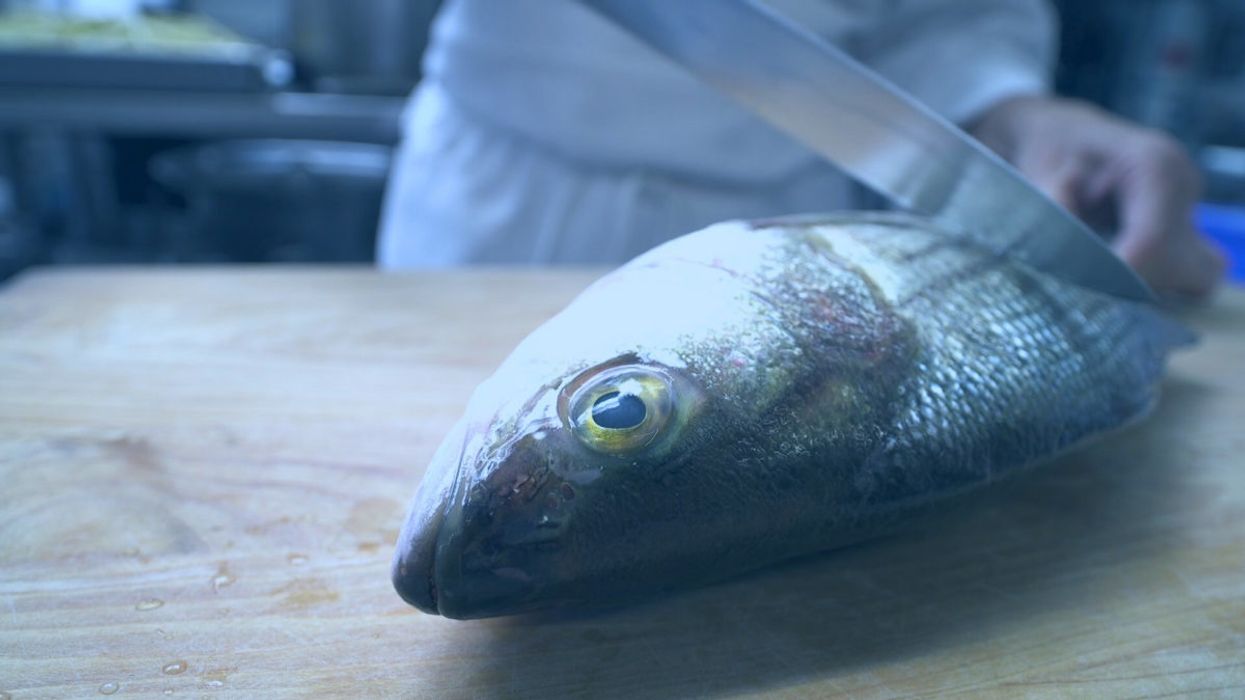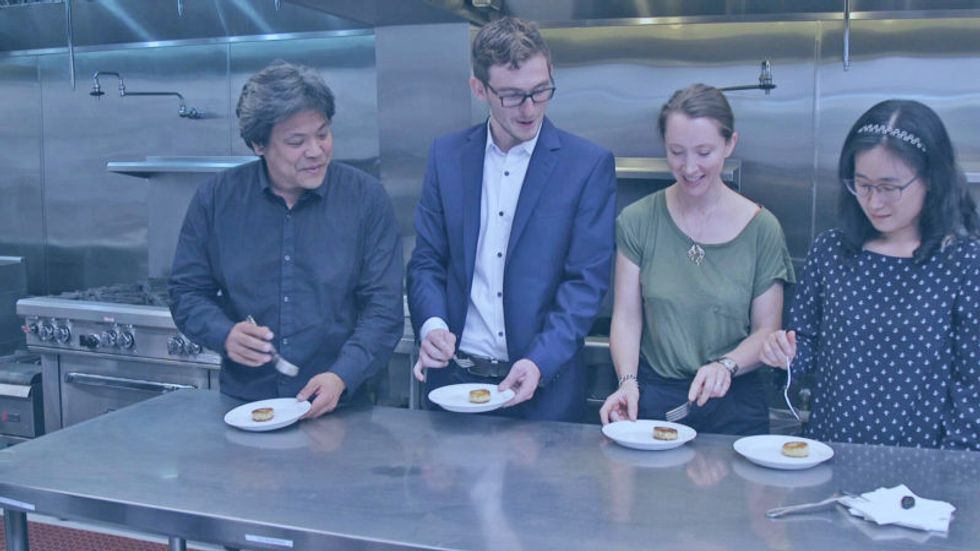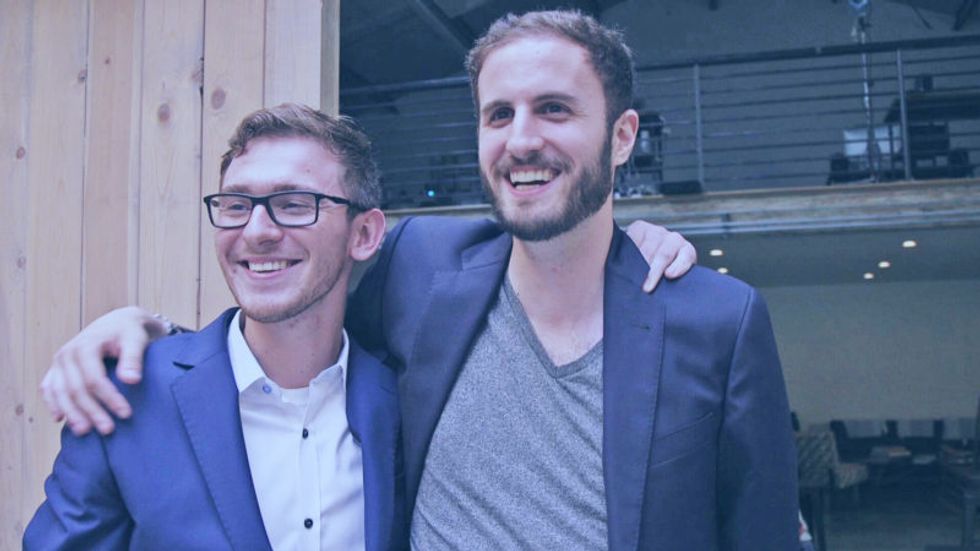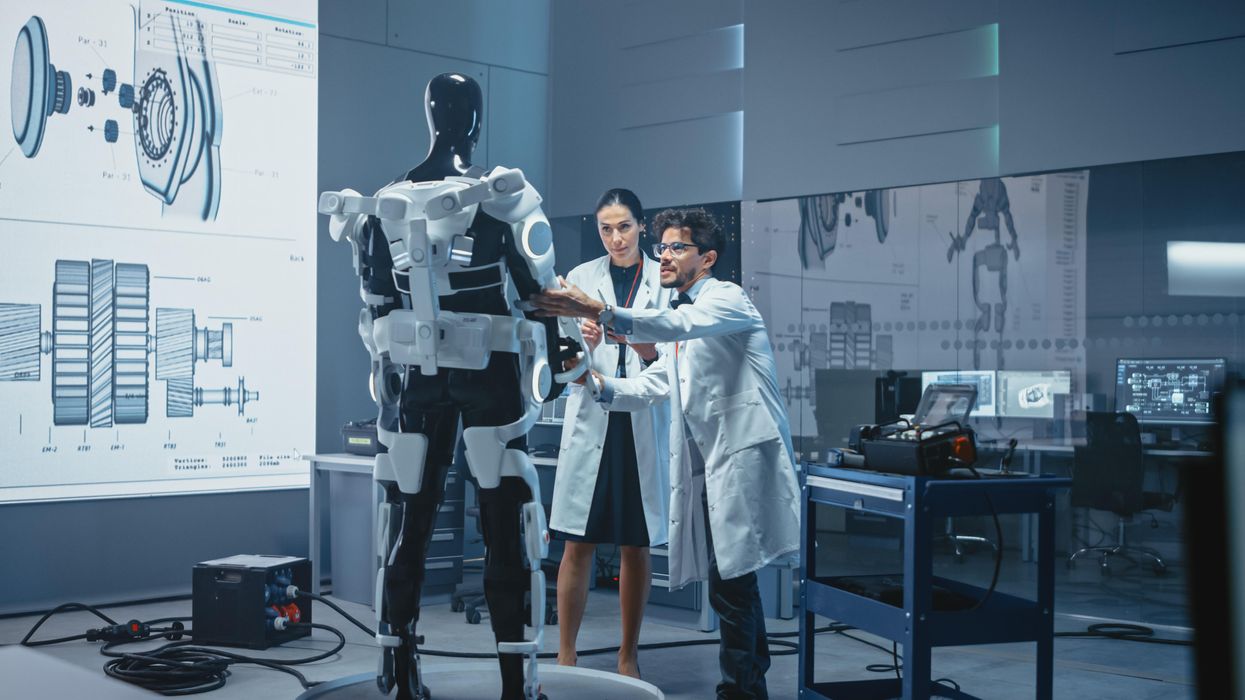Forget Farm-to-Table: Lab-to-Table Fresh Fish Is Making Waves
Kira Peikoff was the editor-in-chief of Leaps.org from 2017 to 2021. As a journalist, her work has appeared in The New York Times, Newsweek, Nautilus, Popular Mechanics, The New York Academy of Sciences, and other outlets. She is also the author of four suspense novels that explore controversial issues arising from scientific innovation: Living Proof, No Time to Die, Die Again Tomorrow, and Mother Knows Best. Peikoff holds a B.A. in Journalism from New York University and an M.S. in Bioethics from Columbia University. She lives in New Jersey with her husband and two young sons. Follow her on Twitter @KiraPeikoff.

A conventionally sourced sea bass from a fishery.
Ever wonder why you've never heard of wild-caught organic fish? It's because there's no way to certify a food that has a mysterious history. Mike Selden, a 26-year-old biochemist with an animal lover's heart and an entrepreneur's mind, decided there must be better way to consume one of our planet's primary sources of animal protein. A way that would eliminate the need to kill billions of fish per year while also producing toxin-free, cheap, delicious fish meat for your dinner table. Enter Finless Foods, a young startup with a bold vision. Selden took time out of chauffeuring fish carcasses around San Francisco (no joke!) to share his journey with LeapsMag.
What is the biggest problem with the way fish is consumed today?
There are a lot of problems ranging from metals to animal welfare to human health. Technology is solving those problems at the same time. You've got extreme over fishing, which is collapsing ocean ecosystems and removing populations of fish that are traditionally used as food sources in developing nations.
In terms of animal welfare, fish are killed in massive numbers, billions a year. Even if people don't care too much about that, we want to give them another option.
In terms of health, which I think for most people is the most convincing argument, current fish have mercury and plastic in them. And if you're getting that fish from a farm, you will also have high levels of antibiotics and growth hormones if you're getting it from outside the U.S. What we're doing is producing fish that doesn't have any of those contaminants.
What gave you the idea to start a company around lab-grown fish?
I studied biochemistry and molecular biology at UMass Amherst, traditionally an agricultural school out in the woods of Massachusetts. I have always been an environmental activist and cared about animals. I thought, animal agriculture is so incredibly inefficient, what could be done to change it?
"The worst way you can possibly make a hamburger is with a cow."
Agriculture is a system of inputs and outputs, the inputs being feed and the outputs being meat – so why are we wasting all of this input on outputs we don't care about? Why are we creating these animals that waste all this energy through sitting around, moving around, having a heartbeat, blinking? All of this uses energy and that's valuable input.
The worst way you can possibly make a hamburger is with a cow. It's an awful transfer of energy: you have to feed it many times its own weight in food that could have fed other people or other things.
In February, I got funding from Indie Bio, a startup accelerator for synthetic biology, and moved out to San Francisco with my co-founder Brian Wyrwas. We started working in our lab in March. We're the newest company in the space.
Walk me through the process of creating edible fish in the lab. Do you have to catch a real live fish first and get their cells?
We have a deal with the Aquarium of the Bay, and whenever a fish dies, they call me, I get in a zip car, drive over, and bring the fish back to the lab, where Brian cultures it up into a cell culture. We do use real, high-quality fish stock. From there, we get the cells going in a bioreactor in a suspension culture, grow them into large quantities, and then bring them out to differentiate them into the cells people want to eat—the muscle and fat tissue. Then we formulate it and bring it to people's tables.
How long does the whole process take from the phone call about the fish dying to the food on the table?
There are two different processes: One is a research process, getting the initial cells and engineering them to be what we're looking for.
The other is a production process – we have a cell line ready and need to grow it out. That timing depends on how big of a facility we have. Since we're working with cell division: If you have 1 cell, in 24 hours, you'll have two cells. Let's say you have 1 ton of cells, in 24 hours you'll have two tons of cells.
"We want to give people the wholesome food they are used to in a healthier setting."
How are you looking to scale this process?
We're trying to find a middle ground between efficiency and local distribution. Organic farming is hilariously bad for the environment and horrifyingly inefficient, but on the other hand, industrial agriculture requires lots of transport, which is also bad for the environment. We're looking to create regionally distributed facilities which don't require a lot of transit, so people can have fresh fish even extremely far inland.
What kinds of fish are you "cooking"?
Our first product will be Bluefin tuna. It's a high-quality fish with high demand and it's also a conservation issue. We also currently have a culture going with Branzino, European sea bass, that we're really happy with.
There's a concept in science called a model organism – one that is extremely well studied and understood. Like the fruit fly, for example. For fish, it's the zebra fish, which is used for genetic research, but no one eats it. It's tiny, so we started by thinking: what fish do people eat that is also close evolutionarily to the zebra fish? We came up with carp, even though it's not too widely eaten.
But our process is very species agnostic. We've done work in trout, salmon, goldfish. Any fish with a dorsal fin works with our process. We tried a wolf eel but it didn't work. Eels are pretty far evolutionarily from fish, so we dropped that one.

From left to right, Ron Shigeta (IndieBio), Brian Wyrwas (Finless Foods), Amy Fleming (The Guardian), and Jihyun Kim (Finless Foods) tasting the first ever clean carp croquettes.
(Courtesy Mike Selden)
Why fish as opposed to, say, a cow?
Scientifically, there are a lot of advantages. Fish have a simpler structure than land animals. A fillet from a cow has complex marbling going on between the fat and muscle. When it's fish, like sashimi, it's in layers of muscle and fat. So it's simpler to build, plus fish are cold-blooded, so because they breathe underwater, our equipment needs less complexity. We don't need a CO2 line and we don't need to culture our cells at 37 degrees Celsius. We culture them at room temperature.
It's also easier to get to market since there's much higher value. Chicken in the last year was $3.84 per pound in America, whereas Bluefin tuna is between $100 and $1200 a pound. Because this is about dropping cost, we can get to market faster and give investors a better value proposition.
What's also cool is that something like Bluefin tuna is something many people haven't had the opportunity to eat. We can get these down in cost until there is price parity with any cheap conventional fish. We want to give people a choice between buying something like albacore tuna in a can –with mercury and plastic– or high-quality tuna without any contaminants for the same price.
Do you shape them like fish fillets to help the consumer overcome whatever discomfort they might feel about eating a bunch of lab-grown cells?
Yeah, people want to continue eating food they are eating, and that's fine. We want to give people a better option. We don't want to give them something weird and out there. We want to give them the wholesome food they are used to in a healthier setting that also solves some environmental issues.
How about the taste? Have you done any blind side-by-side tests with the real thing and your version?
Not blind taste tests. But we have been tasting it, and it is firmly fish. I even tried leaving it outside of the fridge – and man, that tasted like spoiled fish.
We want it to have the exact same properties as real fish. We don't want people to have to learn how to cook with it. We want them to just bring it into their homes and eat it exactly like they were doing before, but better.
What you're growing isn't the whole fish, right? It is not an actual organism?
Right, we're only growing muscle cells. It doesn't know where it is. There is no brain, nervous system, or pain receptors.
Are you the only people in this lab-grown food space working on fish?
We're the only ones doing fish so far. Other companies are doing chicken, duck, egg white, milk, gelatin, leather, and beef.
Are people generally weirded out by sci-fi lab food, or intrigued?
It's been very positive. When people sit down and talk to us, they realize it's not some crazed money grab or some weird Ted talk, it's real activists using real science trying to solve real problems. Sure, there will be some pushback from people who don't understand it, and that's fine.
When can I expect to see Finless Food at my local Whole Foods?
We plan on being in restaurants in two years, and grocery stores in four years.
What about people who aren't big fans of fish in the first place? Like those who don't eat sushi, because consuming something raw with an unknown history isn't very appetizing.
There are too many examples of food poisoning because fish are in a less clean environment than they should be, swimming around in their own fecal matter, and being doused in antibiotics so their diseases don't transmit. It's a bit of a mess. That's why as an industry, we're calling this clean meat. Fish is a healthy thing, or at least it should be, with Omega 3 and 6, and DHA. This is a way for people to continue getting those nutrients without any of the questions of where it came from. For people who are skeptical of fish, we invite you to dive in.

Brian Wyrwas, Co-Founder & CSO, and Mike Selden, Co-Founder & CEO
(Courtesy Mike Selden)
Kira Peikoff was the editor-in-chief of Leaps.org from 2017 to 2021. As a journalist, her work has appeared in The New York Times, Newsweek, Nautilus, Popular Mechanics, The New York Academy of Sciences, and other outlets. She is also the author of four suspense novels that explore controversial issues arising from scientific innovation: Living Proof, No Time to Die, Die Again Tomorrow, and Mother Knows Best. Peikoff holds a B.A. in Journalism from New York University and an M.S. in Bioethics from Columbia University. She lives in New Jersey with her husband and two young sons. Follow her on Twitter @KiraPeikoff.
Friday Five: These boots were made for walking, even for people who can't
New boots could have you moving like Iron Man, based on research this month by Stanford scientists.
The Friday Five covers important stories in health and science research that you may have missed - usually over the previous week but, today, we're doing a lookback on breakthrough research over the month of October. There are plenty of controversies and troubling ethical issues in science – and we get into many of them in our online magazine – but this news roundup focuses on scientific creativity and progress to give you a therapeutic dose of inspiration headed into the weekend.
Listen on Apple | Listen on Spotify | Listen on Stitcher | Listen on Amazon | Listen on Google
This Friday Five episode covers the following studies published and announced over the past month:
- New boots could have you moving like Iron Man
- The problem with bedtime munching
- The perfect recipe for tiny brains
- The best sports for kids to avoid lifelong health risks
- Can virtual reality reduce pain?
Should egg and sperm donors reveal their identities? The debate pivots on genetics and medical history.
Cassandra Adams performs on stage at the Jersey City Theater Center in March 2019 to raise awareness about traumatic experiences that she and others have had with anonymous donor conception.
Until age 35, Cassandra Adams assumed her mother and father were her biological parents. Then she took saliva tests through two genealogy databases—23andMe and AncestryDNA—and discovered a discrepancy in her heritage. In bringing up the matter with her parents, she learned that fertility issues had led the couple to use a sperm donor.
“Most people my age were not told,” said Adams, now 40 and a stay-at-home mom in Jersey City, New Jersey, who is involved with donor-conception advocacy. “Even now, there’s still a lot of secrecy in the industry. There are still many parents who aren’t truthful or planning not to be truthful with their children.”
While some of those offspring may never know a significant part of their medical history, Adams is grateful that she does. Surprisingly, the DNA test revealed Jewish ancestry.
“There are a lot more genetic conditions that run in Jewish families, so it was really important that I get my medical history, because it’s very different from my dad who raised me,” said Adams, who has met her biological father and two of three known half-siblings. As a result of this experience, she converted to Judaism. “It has been a big journey,” she said.
In an era of advancing assisted reproduction technologies, genetics and medical history have become front and center of the debate as to whether or not egg and sperm donations should be anonymous – and whether secrecy is even possible in many cases.
Obstacles to staying anonymous
People looking to become parents can choose what’s called an “identity-release donor,” meaning their child can receive information about the donor when he or she turns 18. There’s no way to ensure that the donor will consent to a relationship at that time. Instead, if a relationship between the donor and child is a priority, parents may decide to use a known donor.
The majority of donors want to remain anonymous, said reproductive endocrinologist Robert Kiltz, founder and director of CNY Fertility in Syracuse, New York. “In general, egg and sperm donation is mostly anonymous, meaning the recipient doesn’t know the donor and the donor doesn’t know the recipient.”
Even if the donor isn’t disclosed, though, the mystery may become unraveled when a donor-conceived person undergoes direct-to-consumer genetic testing through ancestry databases, which are growing in number and popularity. These services offer DNA testing and links to relatives with identifiable information.
In the future, another obstacle to anonymity could be laws that prohibit anonymous sperm and egg donations, if they catch on. In June, Colorado became the first state in the nation to ban anonymous sperm and egg donations. The law, which takes effect in 2025, will give donor-conceived adults the legal authority to obtain their donor’s identity and medical history. It also requires banks that provide sperm and egg collection to keep current medical records and contact information for all donors. Meanwhile, it prohibits donations from those who won’t consent to identity disclosures.
“The tradition of anonymous sperm or egg donation has created a vast array of problems, most significantly that the people thus created want to know who their mommy and daddy are,” said Kenneth W. Goodman, professor and director of the Institute for Bioethics and Health Policy at the University of Miami Miller School of Medicine.
“There are counter arguments on both sides. But the current situation has led to great uncertainty and, in many cases, grief,” Goodman said.
Donors should bear some moral responsibility for their role in reproduction by allowing their identity to be disclosed to donor-conceived individuals when they turn 18, Goodman added, noting that “there are counter arguments on both sides. But the current situation has led to great uncertainty and, in many cases, grief.”
Adams, the Jersey City woman who learned she was Jewish, has channeled these feelings into several works of art and performances on stage at venues such as the Jersey City Theater Center. During these performances, she describes the trauma of “not knowing where we come from [or] who we look like.”
In the last five years, Kathleen “Casey” DiPaola, a lawyer in Albany, New York, who focuses her practice on adoption, assisted reproduction and surrogacy, has observed a big shift toward would-be parents looking to use known sperm donors. On the other hand, with egg donation, “I’m not seeing a whole lot of change,” she said. Compared to sperm donation, more medical screening is involved with egg donation, so donors are primarily found through fertility clinics and egg donor agencies that prefer anonymity. This leads to fewer options for prospective parents seeking an egg donor with disclosed identity, DiPaola said.
Some donors want to keep in touch
Rachel Lemmons, 32, who lives in Denver, grew interested in becoming an egg donor when, as a graduate student in environmental sciences, she saw an online advertisement. “It seemed like a good way to help pay off my student loan debt,” said Lemmons, who is married and has a daughter who will turn 2-years-old in December. She didn’t end up donating until many years later, after she’d paid off the debt. “The primary motivation at that point wasn’t financial,” she said. “Instead, it felt like a really wonderful way to help someone else have a family in a few weeks’ time.”
Lemmons originally donated anonymously because she didn’t know open donations existed. She was content with that until she became aware of donor-conceived individuals’ struggles. “It concerned me that I could potentially be contributing to this,” she said, adding that the egg donor and surrogacy agency and fertility clinic wouldn’t allow her to disclose her identity retroactively.
Since then, she has donated as an open donor, and kept in touch with the recipients through email and video calls. Knowing that they were finally able to have children is “incredibly rewarding,” Lemmons said.
When to tell the kids
Stanton Honig, professor of urology and division chief of sexual and reproductive medicine at Yale School of Medicine, said for years his team has recommended that couples using donor sperm inform children about the role of the donor and their identity. “Honesty is always the best policy, and it is likely that when they become of age, they might or will be able to find out about their biological sperm donor,” he said. “Hiding it creates more of a complicated situation for children in the long run.”
Amy Jones, a 45-year-old resident of Syracuse, N.Y., has three children, including twins, who know they were conceived with anonymous donor eggs from the same individual, so they share the same genetics. Jones, who is a registered nurse and asked for her real name not to be published, told them around age seven.
“The thought of using a known donor brought more concerns—what if she wanted my babies after they were born, or how would I feel if she treated them as her own every time I saw her?” said Jones.
“I did a lot of reading, and all psychologists said that it is best to start the conversation early,” she recalled. “They understood very little of what I was telling them, but through the years, I have brought it up in discussion and encouraged them to ask questions. To this day, they don't seem to be all that interested, but I expect that later on in life they may have more questions.”
Jones and her husband opted to use a donor because premature ovarian failure at age 27 had rendered her infertile. “The decision to use an egg donor was hard enough,” she said. “The thought of using a known donor brought more concerns—what if she wanted my babies after they were born, or how would I feel if she treated them as her own every time I saw her?”
Susan C. Klock, a clinical psychologist in the section of fertility and reproductive medicine at Northwestern University Feinberg School of Medicine, said, “Anonymity is virtually impossible in the age of direct-to-consumer genetic testing.” In addition, “selecting an identity-release donor is typically not the first thing parents are looking at when they select a donor. First and foremost, they are looking for a donor with a healthy medical background. Then they may consider donor characteristics that resemble the parents.”
The donor’s medical history can be critical
Donor agencies rely on the self-reported medical history of egg and sperm donors, which can lead to gaps in learning important information. Knowing a donor’s medical history may have led some families to make different or more well-informed choices.
After Steven Gunner, a donor-conceived adult, suffered from schizophrenia and died of a drug overdose at age 27 in 2020, his parents, who live in New York, learned of a potential genetic link to his mental illness. A website, Donor Sibling Registry, revealed that the sperm donor the couple had used, a college student at the time of donation, had been hospitalized during childhood for schizophrenia and died of a drug overdose at age 46. Gunner’s story inspired Steven’s Law, a bill that was introduced in Congress in July. If passed, it would mandate sperm banks to collect information on donors’ medical conditions, and donors would have to disclose medical information the banks weren’t able to find.
With limited exceptions, the U.S. Food and Drug Administration requires donors to be screened and tested for relevant communicable disease agents and diseases such as HIV, hepatitis viruses B and C, the Zika virus and several STDs. With current technology, it is also impossible to screen for thousands of rare genetic diseases. “If a couple is using IVF (in vitro fertilization) to conceive with the donor gamete, some may opt for pre-implantation genetic testing to assess for chromosomal abnormalities,” Klock said.
Even these precautions wouldn't cover every disease, and some would-be parents don't get the genetic screening. In a situation where one donor has a large number of offspring, it is concerning that he or she can spread a rare disease to multiple people, said Nick Isel, 37, of Yorkville, Illinois, who was conceived with donor sperm due to his parents’ fertility issues. They told him the truth when he was a teenager, and he found his biological father with a journalist’s help.
Since 2016, Isel, who owns a roofing company, has been petitioning the FDA to extend the retention of medical records, requiring the fertility establishment to maintain information on sperm and egg donors for 50 years instead of the current 10-year mandate.
“The lack of family health information,” he said, “is an ongoing, slow-motion public health crisis since donor conception began being regulated by the FDA as a practice.”

